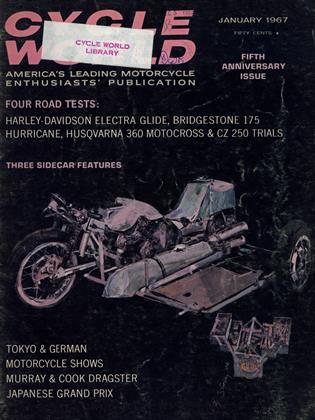REPORT FROM ITALY
CARLO PERELLI
THERE IS NOTHING more difficult for the poor motorcycling journalist than getting facts and data about MV racing machines, which at the moment are Italy's most successful. One can know quite well the racing manager, the technicians, the mechanics, one can talk and laugh with them, but when it comes to the "point," their faces become suddenly serious and their mouths silent. The unpredictable and authoritative boss of the factory, Count Domenico Agusta, wants, in fact, the utmost secrecy to be kept about his racing mounts, so it is also extremely difficult to photograph them, especially without fairings.
The accompanying photos of the 498cc three-cylinder model which Agostini took to world honors in 1966 against the mighty Hondas, are therefore (please excuse the immodesty) a big success. After long "gestation," the three-cylinder MV appeared as a 350cc at the 1965 German GP. Seldom has a debut been more brilliant. Agostini shattered the Honda opposition so much that in a vain attempt to follow him, Redman crashed.
The four-stroke, double ohc, three-cylinder layout is quite unconventional for GP racing machines, having been used only once in the past for the 500cc supercharged Moto Guzzi raced only once in 1939. (In the two-stroke field for GP racing, we had, about ten years ago, the 350cc DKW and now MZ are developing a 125cc.) For sheer specific power output this scheme is, of course, inferior to the four or more cylinder machines. In fact, the latest MV "threes" 350cc and 500cc engines have about the same power as the same stable's "old fours" (55 bhp at 12,500 and 70 bhp at 11,500), but the "threes" have an advantage with less weight, less frontal area, less bulk and therefore better acceleration (owing also to the seven-speed gearbox compared to six.speeds on the "fours"), better handling, road-holding and streamlining. Moreover, the engine is less complicated which, in racing, means fewer possibilities of breaking something.
In the MV "three" the two ohc are driven by spur gears on the right, and one of these also actuates the contact breaker for the coil-battery ignition. Much speculation has been made over the number of valves and it is more commonly accepted that there are three to each cylinder, two for inlet and one for exhaust (quite a contrast to the 1952 works 350cc AJS single layout, which had two valves for the exhaust and one for the inlet). It would be interesting to know at which degrees the crankpins are set; however, this remains a deep mystery. The primary drive gears are on the left, the gear on the crankshaft being set, aj> on the "fours," between the first and the second cylinder to limit crankcase width; the dry type clutch runs, of course, on the same side under the engine and is exposed for better cooling. There is a long, finned sump which holds 4 to 4.5 kgs of oil.
A broken contact spring at the Japanese GP, cost Agostini the 1965 350 world title by a few points. In 1966 the Count decided to go further and a 420cc version was developed, soon followed by a 470cc and finally by a 498cc. Bore and stroke measurements for the three-fifty are 52x54mm, but for the other versions the measurements are unknown. With the 350, Agostini ran a close second to HailwoodHonda in the world title chase, while the 500 success of the dashing young Italian rider has already been chalked up.
* * *
Fifty cc sports machine racing is fun for the beginner; but also "rough-riding" with a similar capacity machine can be quite pleasant, provided a good mount is chosen. For example, the new Morini "Cross" 50 is notable not only for its sturdy and powerful vertical ohv engine with a foot-shift four-speed gearbox, but also for its general layout. It offers a good riding position, both seated and standing on the rests, and excellent traction from the engine. Top speed is 50 mph. The weight is 136 lbs. and the bike has 18-inch wheels. The only snags are the heel-andtoe gearchange lever, which prevents swapping cogs while riding standing on the rests, and the stiff suspension. ■












